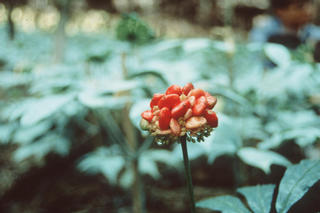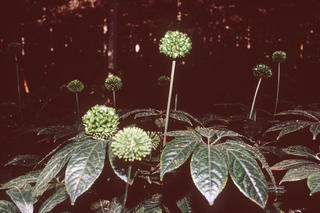Difference between revisions of "Panax notoginseng"
(Created page with "right right == Nomenclature== === Other Names:=== == Historical Use of Panax notoginseng== === Panax notoginseng in Traditional Chinese M...") |
(No difference)
|
Latest revision as of 11:27, 21 March 2013
Contents
Nomenclature
Other Names:
Historical Use of Panax notoginseng
Panax notoginseng in Traditional Chinese Medicine
Background
Sanqifen ÈýÆß·Û
Chinese Name (pinyin): Sanqi
Chinese Name :
Common Name :Notoginseng, Sanqi
Specific Name : Radix notoginseng
Scientific Name:
Collection : The drug is collected before flowering in autumn, washed clean, divided into main root, branch root and rhizome and dried. The branch root known as "Jintiao" and rhizome is known as "Jiankou"
Description : Main roots subconical or cylindrical, 1 - 6 cm long, 1 - 4 cm in diameter. Externally greyish brown or greyish yellow with interrupted longitudinal wrinkles and branch root scars at the apex surrounded by warty protrudings. Texture heavy and compact, fracture greyish green or greyish white. Wood slightly radially arranged, Odour slight, taste bitter and sweet.Jintiao: Cylindrical, 2 - 6 cm long, the upper end 0.8 cm in diameter, the lower end 0.3 cm in diameter.Jiankou: Irregularly shrunken lump shaped or slat shaped, externally with several conspicuous stem scars and annulations, fracture greyish white in the centre and grey at the margin.
Identification : 1.Powder: Greyish yellow, starch granules fairly abundant, simple granules spherical, semispherical or round polygonal. 4 - 30 µm in diameter, compound granules of 2 - 10 or more components. Fragments of resin canals containing yellow secretion. Scalariform, reticulate and spiral vessels 15 - 55 µm in diameter. Clusters of calcium oxalate infrequent. 50 - 80 µm in diameter.2.Macerate 0.5g of the powder in 5 ml of water by gentle heat for 30 minutes (or by shaking for 1 hour) and filter. Transfer a quantity of the filtrate to the test tube, stopper tightly, shake vigorously for 1 minute, a persistent foam is produced.3.Macerate 2g of the powder in 15 ml of methanol by gentle heat for 30 minutes (or by shaking for 1 hour) and filter. Evaporate 1 ml the filtrate to dryness. Add 1 ml of acetic anhydride and 1 - 2 drops of sulfuric acid, a yellow acetic anhydride and 1 - 2 drops of sulfuric acid, a yellow colour is produced, which turns gradually to red, violet, blue and dull green. Drop the filtrate on the filter paper, dry and examine under the ultra violet light (365 nm), a pale blue fluorescence is produced. Add 1 drop of each of a saturated solution of boric acid in acetone and 10% citric acid solution, dry and examine under ultra violet light. A strong yellowish green fluorescence is produced.4.To 0.5 g of the powder add 5 drops of water, stir well, add 5 ml of n-butanol saturated with water, stopper tightly, shake for about 10 minutes. Allow to stand for 2 hours centrifuge. To the supernatant solution, add 3 volumes of water saturated with n-butanol, mix well and allow to stand (cetrifuge if necessary). Evaporate the n-butanol solution to dryness in an evaporation dish. Dissolve the residue in 1 ml of methanol as test solution. Dissolve ginsenoside Rb1 CRS, notoginsenoside R1 CRS and gingsenoside Rg1 CRS in methanol to produced a mixture containing 2.5 mg of each per ml as reference solution. Carry out the method for thin layer chromatography (Appendix Vl B) using silica gel G as the coating substance and the lower layer of chloroform ethyl acetate-methanol-water (15:40:22:10) standing below 10ºC as the mobile phase. Apply separately to the plate 1 µl of each of the two solutions. After developing and removal of the plate, dry it in the air. Spray with sulfuric acid solution (1Õ10) and heat at 105ºC for about 10 minutes. The spots in the chromatogram obtained with the test solution correspond in position and colour to the spots in the chromatogram obtained with the reference solution. Examine under ultra violet light (365 nm), the chromatogram shows the same fluorescence spots.
Processing : Powder of Radix Notoginseng: Wash clean, dry and pulverize to fine powder.
Action : To eliminate blood stasis, arrest bleeding, cause subsidence of swelling and alleviate pain.
Indication : Hemoptysis, hematemesis, epistaxis, hematochezia, abnormal uterine bleeding, traumatic bleeding, prickien pain in the chest and abdomen, traumatic swelling and pain
Precautions : Used with caution in pregnancy.
Dosage : 3 to 9 g; to be ground into powder and taken with water, appropriate quantity for external use.
Storage : Preserve in a cool and dry place, protected from moth.
Synonymns for Panax notoginseng
Patent Medicines and Medicines with Multiple Ingredients that include Panax notoginseng
Pharmaceutical Information
Chemical Constituents
Evidence or the Use of Panax notoginseng in the Treatment of Epilepesy
Basic Science
Animal Studies
Cohort, Case-Control and Non-Randomized Trials
Randomized Controlled Trials
Meta-Analysis
1st Five Results: pubmed search
Junyan Xia, Cong Chen, Yanan Sun, Sinai Li, Yuxuan Li, Bai-Ru Cheng, Yanting Pang, Yan Li, Dong Li, Qian Lin
Panax quinquefolius saponins and panax notoginseng saponins attenuate myocardial hypoxia-reoxygenation injury by reducing excessive mitophagy.
Cell Biochem Biophys: 2024;
[PubMed:38713401]
[WorldCat.org]
[DOI]
(I a)
Lin-Lin Wang, Man-Lin Kang, Can-Wen Liu, Liang Liu, Biao Tang
##Title##
Am J Chin Med: 2024;1-19
[PubMed:38699996]
[WorldCat.org]
[DOI]
(I a)
Haiyan Li, Qian Hua, Shuo Cheng, Xiaoge Liu, Qingyuan Cai, Jiani Zhang, Tiantian Peng, Jiao Li, Chunxiang Wang, Chengbang Liang, Yu Shi, Xu Wang, Yan Tan
The NeuroProtect Formula: A Preventive Approach to AD Targeting the HIF-1/PI3K-AKT Signaling Pathway Evaluated through In Vivo, In Vitro, and Network Pharmacology Approaches.
Comb Chem High Throughput Screen: 2024;
[PubMed:38676511]
[WorldCat.org]
[DOI]
(I a)
Yingjie Zhou, Yanwei Liu, Siwen Li, Qiliang Yang
##Title##
Microorganisms: 2024, 12(4);
[PubMed:38674727]
[WorldCat.org]
[DOI]
(P e)
Hui Zhang, Jianxiu Li, Mengxue Diao, Jianbin Li, Nengzhong Xie
Production and pharmaceutical research of minor saponins in Panax notoginseng (Sanqi): Current status and future prospects.
Phytochemistry: 2024, 223;114099
[PubMed:38641143]
[WorldCat.org]
[DOI]
(I a)

